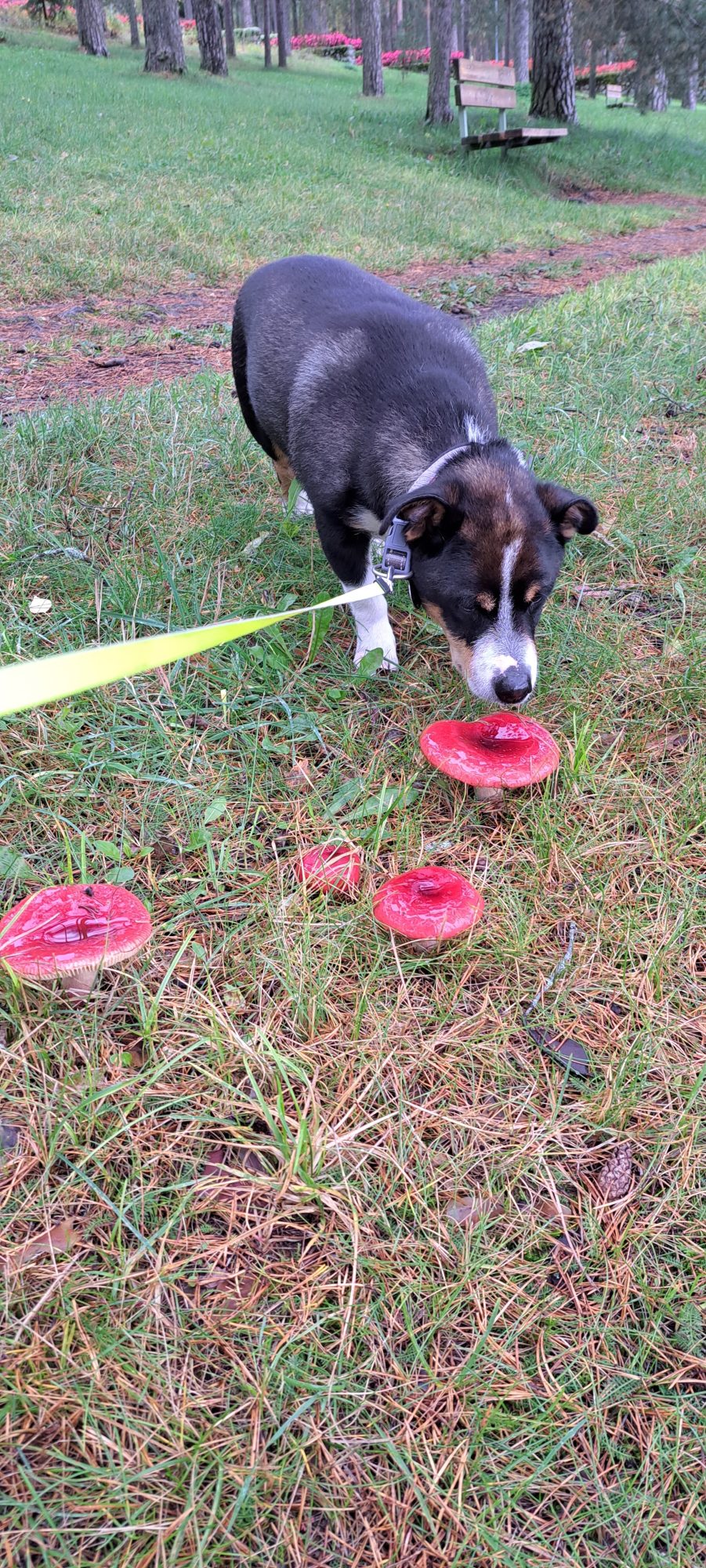Mahdollisia Sankareita
Lapsena sienet tuntuivat uhkaavilta tunkeilijoilta. Ne nousivat maan alta limaisina ja kelmeinä pihan nurkkaan, jossa vielä eilen ei näkynyt mitään. Isot ukonsienet saattoivat kasvaa melkein leukani tasalle. Joidenkin lakki oli omaani leveämpi. Röyhkeydellä ei ollut rajaa. Tuppauduitte sitten siihen rehentelemään ja uhittelemaan! Eräänkin julkean tunkeilijan kiersin niin kaukaa, että äiti alkoi ihmetellä, miksi poikkesin polulta aina tietyssä mutkassa. Selitin jotain metsämansikoista.
Sienien vastenmielisyyttä ei vähentänyt niiden nopea lahoaminen ja tieto siitä, että ne olivat itsekin lahottajia, kuoleman lähettiläitä. Lakkien lierit lurpahtivat pian, jalat pettivät alta, ilman täytti mätänemisen makea lemu.
Nyt aikuisena olen päässyt sienikammostani ja näin syksyisin selkäytimessäni herää muinainen metsästäjäkeräilijän perimä. En ole ainoa. Suomessa metsät kuhisevat sienikoreilla, veitsillä ja kahvitermoksilla varustautuneita kyykistelijöitä ja pyllistelijöitä. Sosiaalinen media täyttyy pullistelevista kantarelli- ja tattivasuista. Minulle poimiminen on arvo sinänsä. Kun löydän yhden kantarellin, huomaan kohta, että viereisellä mättäällä komeilee kymmenen, ja lahon koivun rungon varjossa on koolla kokonainen suku. Keltalakkisina keikistelevien kantarellien kauneudelle ei ole vertaa: ne tuoksuvat miedosti teeltä, niissä ei ole matoja, ne eivät ole limaisia, ja vanhetessaan ne eivät lahoa irvokkaasti haisten kuin tatit, vaan kuihtuvat hienostuneesti pois kuin lehdet.
Entäpä arkiset rouskut, joita pulpahtelee täällä poluille niin paljon, että niitä saa potkia pois? Brittiläiset tutkijat suosittelevat Pnas-lehdessä, että männynleppärouskua lisättäisiin puuntaimien juuriin aina, kun istutetaan metsää. He laskevat, että jos männynleppärouskun ja sen sukulaissienien rihmastoa olisi ympätty kaikkiin niihin sopiviin istutuspuihin maailmassa 2010-luvun ajan, olisi kasvatettu vuosittain sienisatoa määrällä, joka olisi riittänyt ruokkimaan jopa 19 miljoonaa ihmistä. Lisäksi sienet varastoivat hiiltä määrän, joka vastaa kolmannesta maailman vuosittaisista fossiilisten polttoaineiden hiilidioksidipäästöistä[1]. En enää närkästy ukonsienistä, vaikka ne hipoisivat räystäitä.
Tässä viljellään jossiteltuja aterioita, taakse jääneitä mahdollisuuksia. Mutta ei ole vieläkään myöhäistä. Kuulostelen niiden kasvamista.
[1] Current Biology; Helsingin Sanomat 7.9.2023; HS Tiede Luonto 6/2023.
Potenzielle Helden
Als Kind hielt ich Pilze für bedrohliche Eindringlinge. Schleimig und bleich kamen sie aus der Erde hoch, wo am Tag zuvor noch nichts zu sehen gewesen war. Große Riesenschirmlinge konnten mir fast bis ans Kinn reichen. Manche hatten eine Kappe auf, die breiter war als meine. Ihre Unverschämtheit kannte keine Grenzen. Ihr taucht hier ungefragt auf, um zu protzen und zu provozieren! Um einen der anmaßenden Aufdringlinge machte ich einen so weiten Bogen, dass meine Mutter sich wunderte, warum ich in einer bestimmten Kurve immer vom Weg abwich. Ich erzählte ihr etwas von Walderdbeeren.
Die Widerwärtigkeit der Pilze wurde durch ihr schnelles Verroten und das Wissen darüber, dass sie selbst zur Verrottung beitrugen, also Boten des Todes waren, nicht gemindert. Alsbald hingen die Kappenränder schlaff herunter, die Beine gaben nach, die Luft füllte sich mit dem süßlichen Gestank der Fäulnis.
Jetzt als Erwachsene bin ich meine Pilzphobie losgeworden, und so erwacht im Herbst in meinem Rückenmark das uralte Erbgut der Jägerin und Sammlerin. Ich bin damit nicht allein. In Finnland wimmelt es in den Wäldern von mit Pilzkörben, Messern und Kaffeethermoskannen ausgerüsteten Menschen, die sich bücken und den Hintern in die Höhe recken. Die sozialen Medien füllen sich mit überquellenden Pfifferlings- und Röhrlings-Spankörbchen. Für mich ist das Pflücken ein Wert an sich. Wenn ich einen Pfifferling entdecke, merke ich bald, dass auf dem Mooshöcker nebenan zehn weitere prangen und sich im Schatten eines morschen Birkenstamms eine ganze Sippschaft versammelt hat. Die Schönheit der mit ihren gelben Kappen kokettierenden Pfifferlinge kennt keinen Vergleich: Sie duften mild nach Tee, sie haben keine Würmer, sie sind nicht schleimig, und wenn sie altern, verrotten sie nicht grotesk stinkend wie die Röhrlinge, sondern vertrocknen distinguiert wie Blätter.
Und die banalen Reizker, von denen hier auf den Waldwegen so viele aufploppen, dass man sie wegkicken darf? Britische Forscher:innen empfehlen in der Zeitschrift Pnas, Baumsetzlinge immer mit Edel-Reizkern zu kombinieren, wenn man einen Wald pflanzt. Ihre Rechnung geht so: Hätte man in den 2010er Jahren auf der ganzen Welt allen dafür geeigneten Baumsetzlingen Myzele des Edel-Reizkers oder verwandter Pilze aufgepropft, wäre damit eine jährliche Pilzernte erzielt worden, die ausgereicht hätte, bis zu 19 Millionen Menschen zu ernähren. Außerdem speichern Pilze CO2 in einer Menge, die einem Drittel des jährlichen Kohlendioxidausstoßes fossiler Brennstoffe entspricht[1]. Ich nehme keinen Anstoß mehr an Gemeinen Schirmlingen, selbst wenn sie die Traufen berühren sollten.
Hier werden Was-wäre-wenn-Mahlzeiten kultiviert, mit vergangenen Möglichkeiten. Aber noch ist es nicht zu spät. Ich lausche ihrem Wachstum.
[1] Current Biology; Helsingin Sanomat 7.9.2023; HS Tiede Luonto 6/2003.
Übersetzung: Stefan Moster
Potential Heroes
When I was a child, mushrooms felt like dangerous intruders. They rose from the earth moist and slimy in a corner of the yard where just the day before there was nothing to be seen. Large parasol mushrooms could grow almost as high as my chin. Some had caps wider than the one I wore. There was no limit to their impudence. Shoving their way in here, bold as brass, and intimidating people! I gave one particularly brazen interloper such a wide berth that my mother started to wonder why I always detoured off the path at that particular spot. I explained it away with something about wild strawberries.
The repulsiveness of mushrooms was not lessened by their rapid decomposition and the knowledge that they were themselves decomposers, emissaries of death. The brims of their caps soon went droopy, the ground was treacherous underfoot, the air filled with the sweet stench of rot.
Now that I’m an adult I’ve overcome my dread of mushrooms and my ancient hunter-gatherer heritage duly awakens in my spinal cord each autumn. I’m not the only one. The forests of Finland are teeming with stooping and crouching hunters wielding mushroom baskets, knives, and coffee thermoses. Social media is filled with bulging baskets of chanterelles and boletes. For me, the act of mushroom gathering is a value. Once I find a chanterelle, I soon notice that there are ten more handsome ones on the next patch of grass, and a whole family in the shade of a decaying birch stump. Nothing compares to the beauty of the flirty, yellow-capped chanterelles. They smell slightly of tea, they aren’t wormy or slimy, and they don’t rot as they age like the boletes; they gracefully whither away like leaves.
And what about the common milk cap mushrooms that pop up on Finnish trails in such numbers that you can’t kick your way through them? An article by British researchers in the journal Proceedings of the National Academy of Sciences recommends that saffron milk caps should be added around the roots of tree seedlings whenever a forest is planted. They calculate that if all compatible trees planted in the world in the 2010’s had been inoculated with the mycelium of saffron milk caps and related fungi, the annual harvest of mushrooms would have been enough to feed up to 19 million people. Fungi also store a quantity of carbon equal to one third of the world’s annual fossil fuel carbon dioxide emissions[1]. I don’t get angry about the parasol mushrooms anymore, even if they reach up to the eaves.
We’re growing meals wasted and opportunities left behind, but it’s not too late yet. I listen for the sounds of them growing.
[1] Current Biology; Helsingin Sanomat 7.9.2023; HS Tiede Luonto 6/2023.
Translation: Lola Rogers
Teilen












